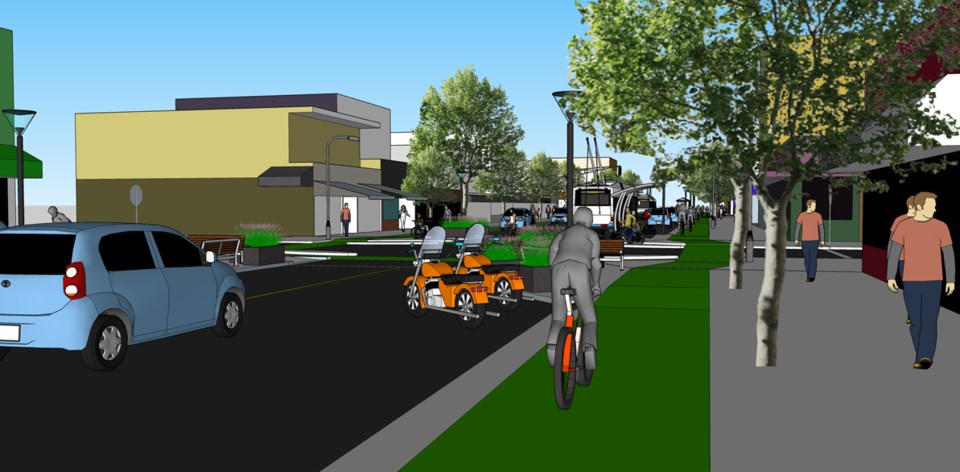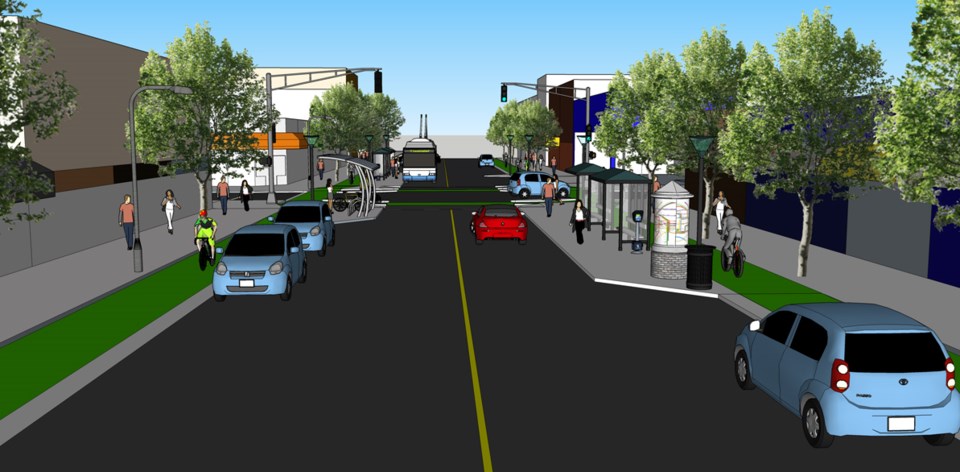Our family loves living on Commercial Drive, but it’s becoming increasingly clear that — as a public space — it doesn’t work for everyone, particularly those who can’t (or won’t) drive everywhere.
The sidewalks are narrow and often too crowded to walk hand-in-hand. There are precious few areas to sit and relax, even at the bus stops. Last but not least, there is no safe space for cycling. And while I’m constantly amazed by those who bravely navigate between buses and cars, it isn’t something my wife, children, or I are about to attempt anytime soon.
Which is why we all got incredibly excited when a group of community-minded citizens calling themselves Streets For Everyone recently released an inclusive, practical, and well-considered proposalfor the redesign of Commercial Drive between East 14th Avenue and Graveley Street. The proposal, still in draft phase open to feedback, will better reflect the changing priorities of the community and really is a win-win-win-win. It features widened sidewalks, increased public seating, bigger (and better) bus stops, one-way, grade-separated cycle tracks, and Dutch-style, protected intersections. Best of all, it simply removes one lane of through traffic and minimal on-street parking space, which leaves little room for the protestation of local business owners.

This is truly a once-in-a-lifetime opportunity to create a street that works for all of its users; a destination where Vancouverites will go out of their way to visit and spend time shopping, dining and socializing. It means people of all ages and backgrounds will be able to live, work, and play on the Drive, regardless of how they get from A to B.
In the grand scheme of things, Commercial Drive represents a tipping point for this city’s ambitions of world-class livability, sustainability, resiliency and accessibility. While Vancouver has a relatively functional bicycle network, it is primarily designed for recreational riding and longer, single-purpose trips (such as cycling to work). But those many other multi-purpose trips one makes in a day (shopping, dining, banking, etc.) become incredibly problematic — particularly with children — when frequenting destinations along West Fourth Avenue, Broadway, Robson or Main Street.
Having our family’s two-wheeled travel relegated to residential side streets means whenever we have a dance class, go grocery shopping, or treat ourselves to dinner on the Drive, we’re forced to either walk or take the bus. Neither is optimal, but they are the only choices we’re given, when cycling involves going several blocks out of your way, then walking your bike on the bustling sidewalk for a few more. Worse yet, we often find ourselves pedaling to another part of town and spending our money at a business located on a more secure and convenient part of the city’s bicycle network.
When we first moved to Vancouver in 2007, we spent the better part of a year getting to know each and every neighbourhood, carefully considering where we would lay down our roots. In the end, we chose an apartment on Commercial Drive because of its direct proximity to (almost) everything we need: an elementary school, Broadway Skytrain station, 10th Avenue Bikeway, Trout Lake Community Centre, and dozens of cafés, markets, and restaurants all within a 15-minute walk.
Six years later, that due diligence has paid back in spades. As we found our automobile collecting dust in the parking garage, we eventually sold it (having purchased a share in the Modo Car Coop), liberating ourselves from thousands of dollars in expenses every year. We weren’t alone, as we watched car-share grow exponentially, and friend after friend went car-free (or car-lite). Local cycling rates also soared: an astonishing 157.9 per cent between 2008 and 2011, with nearly one in six trips in the Grandview-Woodlands neighbourhood now being made by bicycle.
A reduction in car dependence and ownership doesn’t just benefit individual families; it creates wealth that is shared by the entire community. An estimated 85 per cent of what we spend on our cars annually (gas, insurance, purchase price, finance charges) leaves the city. Which means if a city can reduce car ownership by 15,000 cars — a number that could be replaced by 1,150 shared vehicles — a staggering $127 million would stay in the local economy each and every year.
So in the coming weeks — now the municipal election is in full swing — engage with those running for council, those running businesses on the Drive, and the voters who live there. Implore them to send the message that city staff must prioritize walking, cycling, and transit in Grandview-Woodlands, to everyone’s benefit. Visit the Streets For Everyone website, sign their petition, and consider donating your time and/or money. While these crucial upgrades should eventually happen as part of the city’s 2040 Transportation Plan, they are needed sooner rather than later. Because time’s a-wastin’, and my kids are itching to ride their bikes on the Drive.
Chris Bruntlett is the co-founder of Modacity and is inspired to live a happy life of urban mobility. Reach him on Twitter at @modacitylife.



